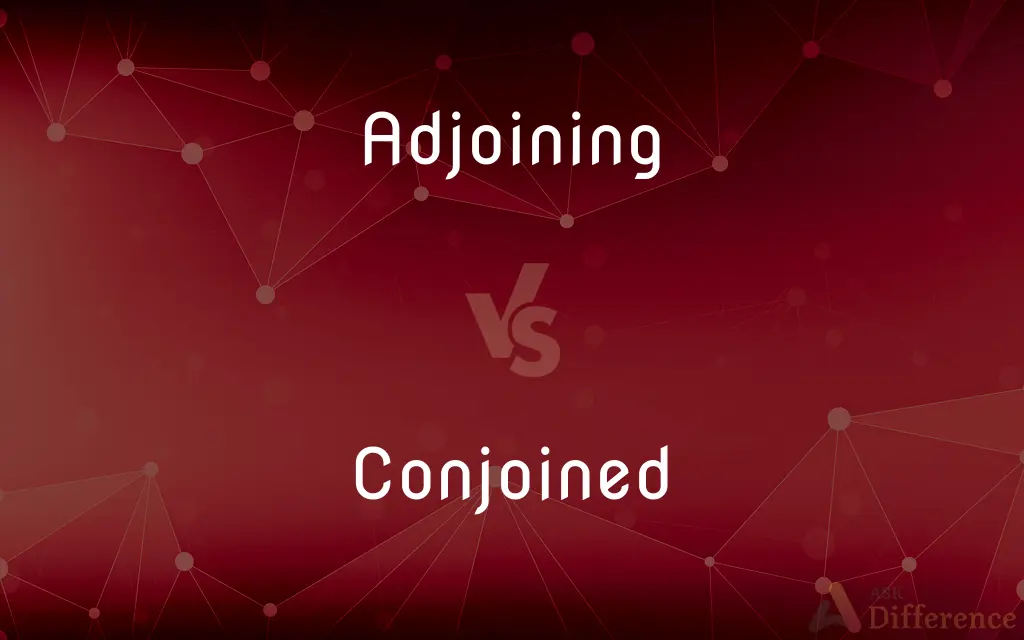Adjoining vs. Conjoined — What's the Difference?
By Urooj Arif & Fiza Rafique — Updated on April 5, 2024
Adjoining spaces share a boundary or are next to each other, whereas conjoined entities are united or linked more closely, often implying fusion or inseparability.

Difference Between Adjoining and Conjoined
Table of Contents
ADVERTISEMENT
Key Differences
Adjoining and conjoined, though seemingly similar, hold distinct implications in terms of spatial relationship and unity. Adjoining refers to the proximity of two entities, emphasizing their being next to each other with a shared boundary, but without implying a direct connection or union. This term is commonly used in real estate, architecture, and spatial planning to describe adjacent spaces or properties. For example, adjoining rooms in a hotel share a common wall but are separate entities. Conjoined, on the other hand, denotes a stronger form of connection, often used to describe things that are united or fused together to the point of inseparability. This term is frequently applied in contexts such as medicine (e.g., conjoined twins), where it describes entities that are physically joined in a way that makes them unable to exist independently without one another.
Adjoining areas or objects maintain their individuality and can function independently while merely being next to each other. This is often seen in structures where rooms or buildings are adjacent but operate separately, allowing for distinct entities within a cohesive environment. Whereas, conjoined implies a level of dependency and integration that adjoining does not, suggesting that the entities not only share space but are also intertwined in function or existence. This is particularly evident in biological or manufactured objects that are physically linked, requiring a more complex separation process, if separation is feasible at all.
The distinction between adjoining and conjoined becomes crucial in understanding the nature of the connection or boundary shared by two entities. Adjoining suggests a side-by-side arrangement with a distinct division, suitable for describing geographical locations, architectural designs, or any scenario where two entities are next to each other but remain separate. In contrast, conjoined implies a deeper, often physical, union that affects the individual characteristics and independence of the entities involved, as seen in cases of conjoined twins or merged organizations.
In terms of implications for spatial and functional relationships, adjoining allows for flexibility and independence, offering the possibility of disassociation or reconfiguration without significant implications for the inherent nature of the entities involved. This is valuable in urban planning and architecture, where adaptability and modularity are key. Conjoined, however, denotes a fixed and often permanent connection that challenges separability and demands consideration of the conjoined entities as a single unit, which can pose unique challenges in medical, legal, and ethical contexts.
Despite their differences, both adjoining and conjoined share the concept of proximity but diverge significantly in terms of the degree of connection and the implications for the entities involved. Understanding these nuances is essential for accurate communication and analysis in various professional and academic fields, reflecting the complexity of relationships and connections in the physical and conceptual world.
ADVERTISEMENT
Comparison Chart
Definition
Being next to or adjacent with a shared boundary.
Physically united or joined, often inseparably.
Implication of Connection
Proximity without physical connection.
A physical or symbolic union.
Independence
Entities remain independent.
Entities may not function independently.
Application Context
Real estate, architecture, spatial planning.
Medicine, biology, legal contexts.
Separability
Easily separable without altering inherent nature.
Separation may be complex or impossible without significant intervention.
Compare with Definitions
Adjoining
Allows for reconfiguration or separation without significant implications.
The adjoining lots can be sold separately or combined, depending on the buyer’s needs.
Conjoined
Physically united or linked, often implying inseparability.
The conjoined twins shared vital organs, making their medical condition unique.
Adjoining
Describes spatial proximity in architecture or geography.
The garden adjoins the house, offering a seamless transition from indoors to outdoors.
Conjoined
Denotes a deeper level of connection or fusion.
The companies underwent a merger, becoming conjoined in their operations and branding.
Adjoining
Emphasizes the independent function of adjacent entities.
The office building and the parking garage are adjoining but operated by different entities.
Conjoined
Reflects a dependency or inability to function independently.
The conjoined structures were designed to support each other, preventing independent alterations.
Adjoining
Common in real estate, urban planning, and spatial design.
Adjoining properties often share utility lines or infrastructure, facilitating planning and development.
Conjoined
Separation, if possible, requires significant intervention.
Surgical procedures to separate conjoined twins involve complex planning and high risks.
Adjoining
Being next to or adjoining with a shared boundary without direct connection.
The adjoining rooms were convenient for the family, allowing easy access between them.
Conjoined
Frequently used in medicine, biology, and related fields.
Conjoined entities, whether in nature or through human action, present unique challenges and considerations.
Adjoining
(of a building, room, or piece of land) next to or joined with
I was in an adjoining room and could hear voices
They ended up buying the adjoining land
Conjoined
To join or become joined together; unite.
Adjoining
Neighboring; contiguous.
Conjoined
Joined together physically, of persons (conjoined twins), or things.
Adjoining
Being in contact at some point or line; joining to
An adjoining room
Conjoined
Joined or bound together; united (in a relationship)
Adjoining
Present participle of adjoin
Conjoined
Combined.
Adjoining
Joining to; contiguous; adjacent; as, an adjoining room.
Upon the hills adjoining to the city.
Conjoined
Simple past tense and past participle of conjoin
Adjoining
Having a common boundary or edge; touching;
Abutting lots
Adjoining rooms
Rhode Island has two bordering states; Massachusetts and Conncecticut
The side of Germany conterminous with France
Utah and the contiguous state of Idaho
Neighboring cities
Conjoined
Joined together or touching.
Conjoined
Consisting of two or more associated entities;
The interplay of these conjoined yet opposed factors
Social order and prosperity, the conjoint aims of government
Common Curiosities
What does adjoining mean?
Adjoining refers to two or more entities that are next to each other, sharing a boundary but remaining independent.
Can adjoining rooms be considered conjoined if they share a common door?
No, adjoining rooms, even with a common door, remain separate entities and do not become conjoined as they maintain their independence and functionality.
What are conjoined twins?
Conjoined twins are two individuals physically connected to each other at birth, sharing organs or limbs, and often cannot be separated without medical intervention.
Can adjoining properties share facilities?
Yes, adjoining properties can share facilities like walls, gardens, or driveways, but they remain distinct and separable entities.
How do conjoined entities differ from adjoining ones in terms of independence?
Conjoined entities may not function independently due to their physical or functional union, unlike adjoining entities that retain their separate identities.
In what contexts is the term "adjoining" most commonly used?
"Adjoining" is most commonly used in real estate, architecture, and spatial planning to describe entities that are adjacent but independent.
What challenges do conjoined twins face?
Conjoined twins may face medical, social, and ethical challenges due to their physical connection and shared organs or body parts.
Is it easier to separate adjoining or conjoined entities?
It is easier to separate adjoining entities since they are next to each other without being physically united, unlike conjoined entities which may require complex procedures for separation.
Are conjoined entities always biological?
No, while conjoined often describes biological connections, such as conjoined twins, it can also refer to merged organizations or entities in other fields.
How do adjoining and conjoined entities impact spatial design?
Adjoining entities impact spatial design by requiring consideration of shared boundaries and transitions, whereas conjoined entities pose unique challenges due to their inseparability and the need for integrated planning.
Share Your Discovery

Previous Comparison
Villa vs. Cottage
Next Comparison
Director vs. ProducerAuthor Spotlight
Written by
Urooj ArifUrooj is a skilled content writer at Ask Difference, known for her exceptional ability to simplify complex topics into engaging and informative content. With a passion for research and a flair for clear, concise writing, she consistently delivers articles that resonate with our diverse audience.
Co-written by
Fiza RafiqueFiza Rafique is a skilled content writer at AskDifference.com, where she meticulously refines and enhances written pieces. Drawing from her vast editorial expertise, Fiza ensures clarity, accuracy, and precision in every article. Passionate about language, she continually seeks to elevate the quality of content for readers worldwide.
















































